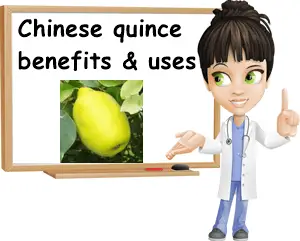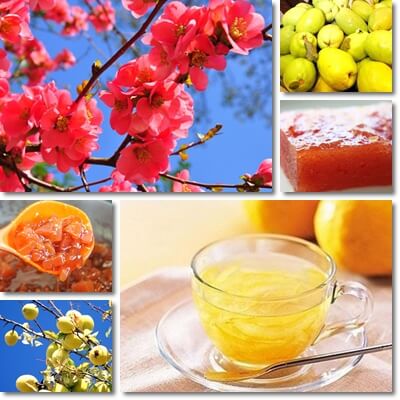The Chinese quince (Pseudocydonia sinensis) is a fuzz-less quince in season from October to December. It belongs to the same family as the European quince and, just like it, it’s best eaten after being softened by frost. Equally aromatic and nutritious as the European quince, it makes a wonderful winter fruit to try this season, whether you eat it raw or make it into jam – and it will make the absolute best-tasting jam you ever had. The fruit has antioxidant, anti-inflammatory, antiviral and blood pressure-lowering properties and is a source of vitamin C, B vitamins and several dietary minerals.
What is a Chinese quince?
A Chinese quince is a species of quince tree native to China and other parts of East Asia. It is related to the European quince and the flowering quinces (species extensively grown for ornamental purposes, despite producing edible fruits as well). Its scientific name is Pseudocydonia sinensis and it belongs to the same family as the European quince, Cydonia oblonga, and the flowering quinces, Chaenomeles cathayensis, C. japonica, C. speciosa and C. thibetica. The species thrives in both warmer and cooler climates and is extremely resilient to pests, drought and a range of growing conditions. The tree as well as the fruits are frost-tolerant. The Chinese quince tree makes an excellent bonsai and is available for sale in nurseries in spring and fall.

What does a Chinese quince look like?
The Chinese quince is large and bulky-looking. It is egg-shaped, slightly larger at the base (the end opposite to the stem), but the fruits don’t always have a regular form. The unripe fruit is green, whereas the ripe fruit is a beautiful golden yellow color.
The skin is extremely thin and smooth, lacking the characteristic fuzz seen in European quinces. The flesh is dense and hard, and modestly juicy. Initially cream-colored, the flesh oxidizes when exposed to air, taking on a brown tint. Chinese quinces have an inedible core in the center, a sort of hollow chamber containing multiple tiny, pointy seeds, reddish brown on the outside and milky white on the inside.
What does a Chinese quince taste like?
Ripe Chinese quinces are tough, dense and not very juicy, with a slightly grainy texture. In addition to this, they taste tart, astringent and draw out the moisture from the mouth, causing one to pucker, even when ripe. At the same time, the ripe fruit is aromatic and full of flavor, with a strong sweet odor. Chinese and other quinces are not generally eaten raw, despite the fact that the whole fruit is edible. You can eat the skin, flesh and even seeds, except for the core/seeds chamber.
Allowing the ripe fruit to be softened and sweetened by frost is a great way to improve its taste and make it more palatable raw.
Chinese quinces are in season starting mid-late October, but can be left on the tree throughout November and even December (depending on climate, yearly variations in weather conditions and on whether or not the individual fruits are healthy, without spots, rot or insects or birds damage). They also keep well throughout winter if stored in a cool, dry place, hence the reason they’re also dubbed winter fruits.
Chinese quinces will continue to ripen even after being harvested – they are best kept at room temperature, preferably in direct sunlight, but sunlight is not that important of a requirement.

Are Chinese quince seeds poisonous?
Eating a few seeds once in a while along with the fruit won’t cause any harm. However, it’s advised to avoid eating Chinese or other quince seeds for the same reason it’s advised to not eat apple pips: in large amounts, the seeds are poisonous. Quince seeds contain toxic compounds that make them taste bitter. During the digestion of the seeds, these compounds release cyanide which is poisonous. Quince, apple and the seeds of other related species have the same effects, hence the recommendation to discard the seeds or plant them.
Recipe ideas and uses
About any part of the Chinese quince tree can be used in one way or another. The tree itself makes a great ornamental and is especially beautiful in autumn when its leaves turn a striking, but beautiful rusty color. The tree can also be cultivated as a bonsai, for aesthetic purposes. The brown bark is quite interesting to look at: flaky and patchy-colored with dark-grey, grey-green, orangey-brown and reddish-brown.
The fruits can be eaten raw, boiled or baked, made into compote, jam, jelly or other preserves (quince cheese, paste and spread), tea, liqueurs, fermented wine-like beverages, a special kind of brandy called eau-de-vie and other alcoholic beverages and digestifs.
Chinese quince nutrition facts
The Chinese quince is modestly nutritious at best, but still a good fruit to introduce into your diet. Its nutrition is fairly similar to that of true quinces and apples. A serving of 100 g of the fruit provides 55-60 kilocalories, and about 15 g of total carbohydrates of which roughly 2 g consist of dietary fiber. The Chinese quince is low in sugar, protein and fat, but high in water (roughly 85% water).
It is a good source of vitamin C and a modest source of iron and potassium. A serving of 100 g of raw Chinese quince has about 15 mg of vitamin C, 0.7 mg of iron and 200 mg of potassium. The ripe fruit also contains small amounts of several essential vitamins and dietary minerals, notably: vitamins B1, B2, B3, B5, B6, B9, calcium, copper, magnesium and phosphorus.
There are astringent tannins in the unripe and ripe raw fruit that cause it to dry out the mouth. You also get this mouth-puckering or mouth-drying sensation after eating true European quinces, persimmon and kaki fruit, unripe bananas and after drinking grape juice, coffee and tea. Also see the benefits of true quinces.
Chinese quince benefits
- Source of dietary fiber with benefits for constipation relief.
- High in pectin, it can be used to bind loose stools and treat non-infectious diarrhea.
- Moderate source of calories (55-60 kilocalories/100 g) – helps with healthy weight loss. Can be eaten raw, boiled or baked.
- Cholesterol-lowering properties thanks to a good dietary fiber content (dietary fiber binds to fat from food at the intestinal level, reducing absorption).
- Boiled and baked Chinese quinces are good for an upset stomach and gentle on the stomach in digestive conditions such as gastritis and peptic ulcers. See what foods to eat and to avoid for gastritis.
- Contains modest amounts of potassium, but no sodium, making it a good food to eat for high blood pressure.
- Raw Chinese quinces are good for healthy teeth and gums thanks to their vitamin C content.
- Immune-boosting, anti-inflammatory and antiviral properties thanks to a good vitamin C content.
- Restorative and tonic properties thanks to iron and B vitamins.
- Anti-aging benefits: vitamin C in the raw fruit stimulates collagen production for better skin elasticity and less wrinkles.
